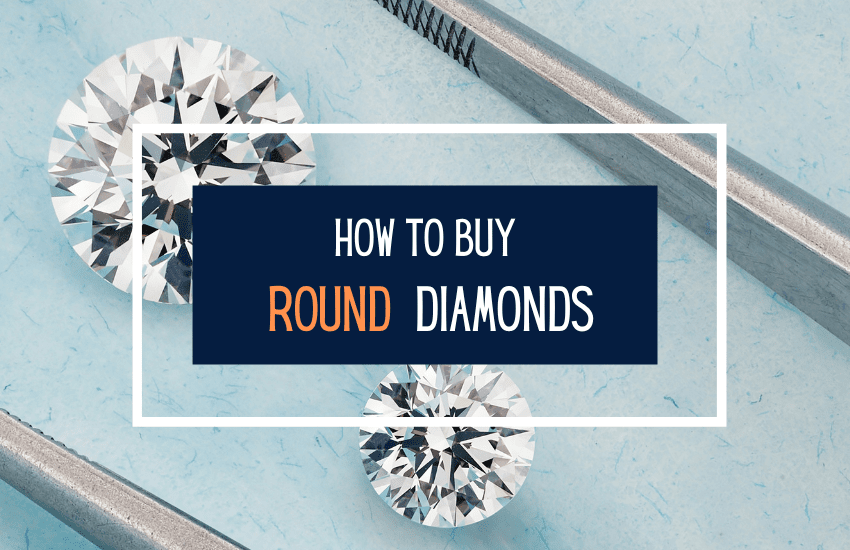
Table of Contents
Round diamonds, also known as round brilliant cut diamonds, enjoy the prestigious position of being the most popular shape for diamond engagement rings.
In fact, over 75% of all diamond engagement rings bought are round. It is a classic shape that looks great on any hand shape and will never go out of style. Let’s take a look at what makes the round diamond the most loved shaped when it comes to engagement rings.
Should I Buy a Round Diamond?
Most people prefer round diamonds as they offer several advantages. However, if you’re on a budget or want something different, there are many other options available. Here’s a quick look at the pros and cons of round diamonds to help you decide.
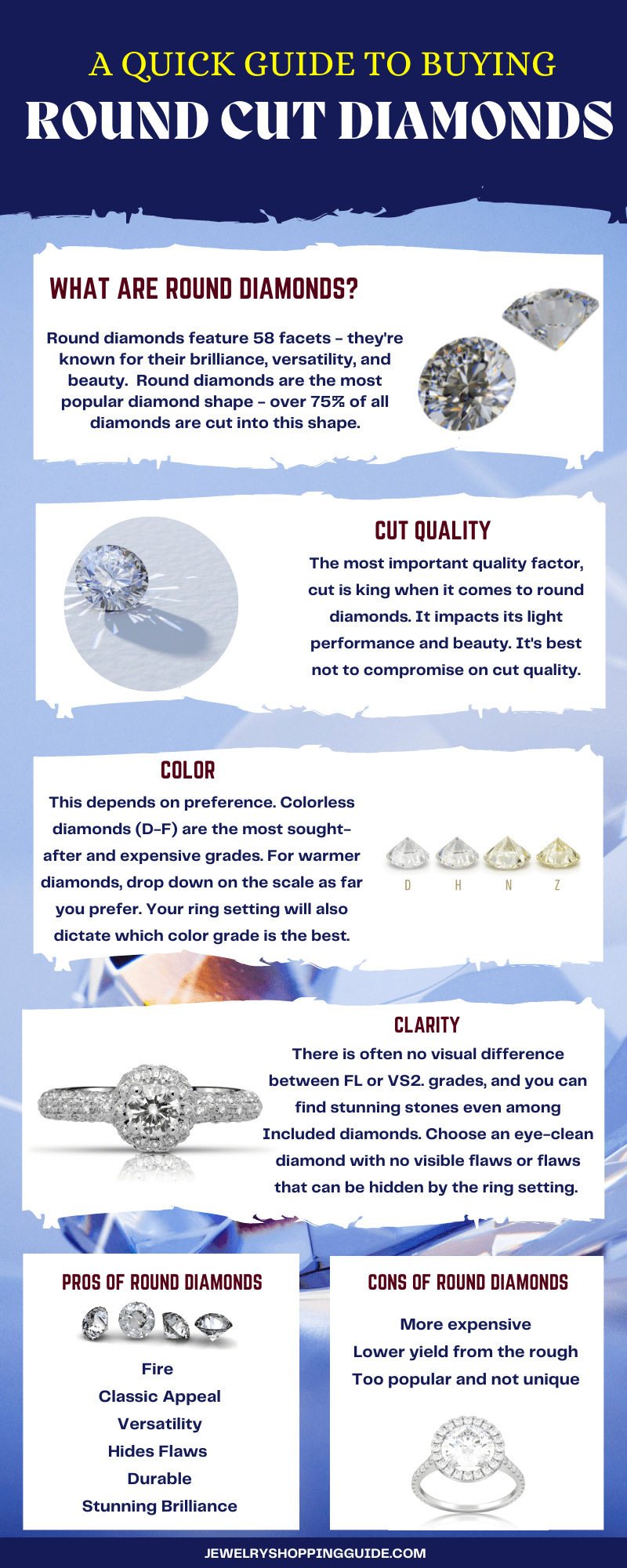
What is the Round Cut Diamond?
Although round shaped diamonds, such as the old mine cut and the Old European cut, were popular from Victorian times, these didn’t have the sophisticated faceting that we know today. However, thanks to theoretical and technological improvements, the round cut diamond evolved over time.
The round diamond became popular around 1919, when Marcel Tolkowsky published his research paper titled “Diamond Design: A Study of the Reflection and Refraction of Light in Diamond”. He highlighted the ideal proportions of a round diamond, noting specifications that would maximize light return. Since then, the cut has been modified and its proportions perfected.
The round diamond contains 58 facets – 33 on the crown of the diamond and 25 on the pavilion. The stone has a cone shape which funnels light through to the top, maximizing the amount of light bouncing back from the diamond, causing the diamond to sparkle brilliantly. Round diamonds are among the most expensive of diamond cuts, due to high demand and lower yield.
Why Is the Round Diamond Cut So Popular?
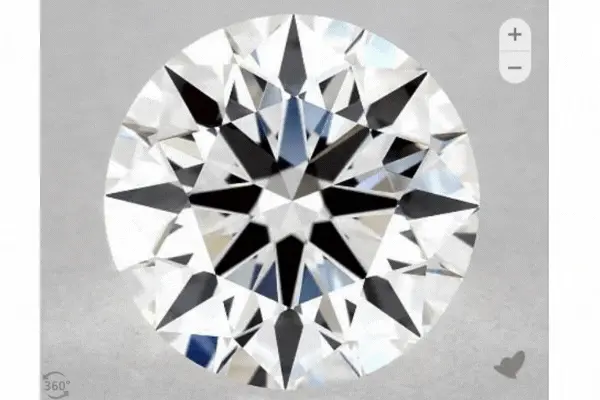
The most popular diamond shape, especially for engagement rings, round diamonds have a lot to offer. Here’s why they’re so popular:
- Brilliance: Brilliance refers to sparkle, caused by white light reflecting off the table of the diamond. An excellent cut round diamond has intense sparkle, which makes the stone look stunning and larger than it is. High-quality round cut diamonds are, therefore, the best option if brilliance is a top priority.
- Fire: Fire refers to the colorful flashes that emanate from a well-cut diamond. It’s the amount of colored light that is dispersed by the diamond, giving the stone a stunning look. While too much fire can be a bad thing (like in large moissanite stones), a perfectly cut diamond will showcase just the right amount.
- Versatility: Round diamonds look stunning on any hand, in any ring design, style, or setting. Because of their versatility, round diamonds look amazing, whether it’s placed in a vintage design, like these ones, or a modern tension ring setting, Like these.
- Classic Appeal: Since the Middle Ages, round diamonds have been used in jewelry and engagement rings. They’re classic and timeless, unlike some diamond cuts that are more limited in their appeal (think the heart cut). You can be sure that a century from now, round diamonds will still be sought after. This makes them a great option for heirloom jewelry.
- Durable: The round diamond doesn’t have any angles and doesn’t have any vulnerable points, unlike shapes such as the princess cut. This means that you won’t have to worry about any points chipping off or being damaged from exposure.
- Hides Flaws: The stunning brilliance of round diamonds means that it can hide small imperfections in the stone. Your eyes will not notice minor inclusions as the brilliance tends to hide and distract from them.
Round Cut Diamond Price
Round shape diamonds are often the priciest of all diamond cuts. First of all, as we mentioned above, round diamonds are the most popular choice for most buyers. High consumer demand often translates to higher prices.
Another factor is the relatively low yield of round diamonds, which results in the stone costing more on a per-carat basis. But what do we mean by low yield?
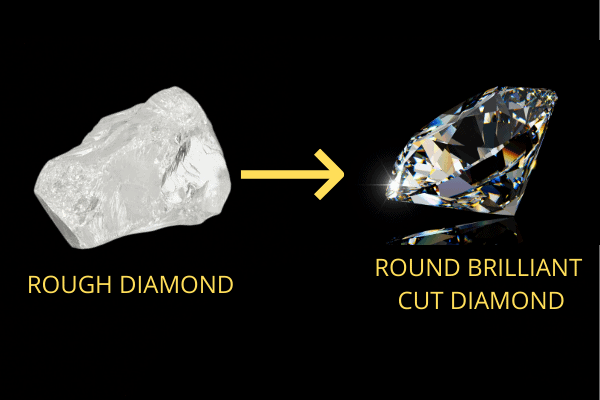
A rough diamond is often a cubic shape while a round diamond is a conical shape. In order to cut the diamond rough into the round cut, a large amount of rough is wasted. Sometimes as much as up to 60% of diamond rough is lost in the cutting process. This results in the remaining stone being priced higher per carat.
The quality factors, which we’ll be discussing below, will impact the overall price of a round diamond. In general, a high-quality 1-carat round diamond will cost around $6000, with larger stones like these ones costing hundreds of thousands of dollars.
For a quick comparison, compare this round diamond with this princess cut diamond. They both have similar specifications, but the round diamond is noticeably more expensive. It is estimated that a round diamond can cost up to 35% more than other diamond cuts.
This may be a price worth paying if your heart is set on a round diamond. But if sticking to a particular budget is important to you, then it may be a good idea to consider a different shape.
Round Diamond Cut
Cut is the most important factor when it comes to round diamonds. After all, it is a round diamond’s brilliance that makes it stand out, and this is mainly defined by the quality of the cut.
Note that diamond cut and diamond shape are two different things. The cut refers to the proportion and technical aspects of the faceting, while the shape refers to the geometrical shape of the stone.
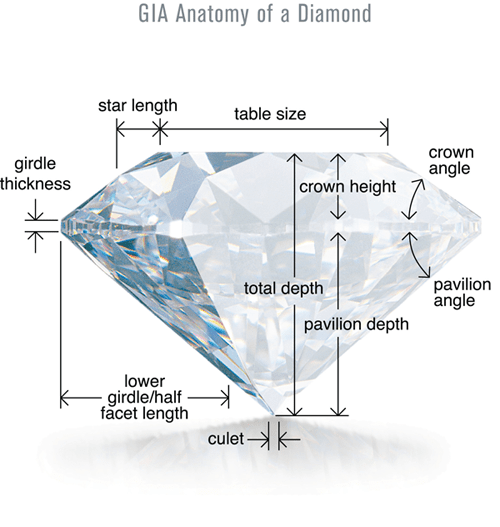
The GIA has created a grading system that allows labs to give round diamonds a cut grading ranging from Excellent, Very Good, Good, and Fair, to Poor. Only round diamonds are given a cut grade by the GIA (although the AGS grades the cut of both round and princess shapes). The better the cut grade, the more expensive the diamond, all else being equal.
Here are the best proportions for Excellent and Very Good round
cuts.
| EXCELLENT | VERY GOOD | |
| Table | 54% – 58% | 53% – 60% |
| Depth | 61.0% – 62.5% | 60.0% – 63.0% |
| Crown Angle | 34.0 – 35.0o | 33.0 – 36.0o |
| Pavilion Depth | 42.8 – 43.2 | 42.0 – 42.7 |
| Pavilion Angle | 40.6 – 41.0o | 40.2 – 41.4o |
| Girdle Thickness | Thin – Slightly Thick | Very Thin – Thick |
| Culet Size | None | Very Small |
| Polish/Symmetry | Excellent – Very Good | Excellent – Very Good |
Compare these two cut grades here:
1 Carat G Color VS1 Clarity Excellent Cut Round Diamond
1 Carat G Color VS1 Clarity Very Good Cut Round Diamond
While the cut grade is important, take the time to check how the stone interacts with light and whether it looks good to the eye. Although cut is one aspect where it’s best not to compromise, you could still pick a beautiful diamond lower on the cut scale and still get a beautiful stone. Check out HD videos and images of the diamond and see how it interacts with light.
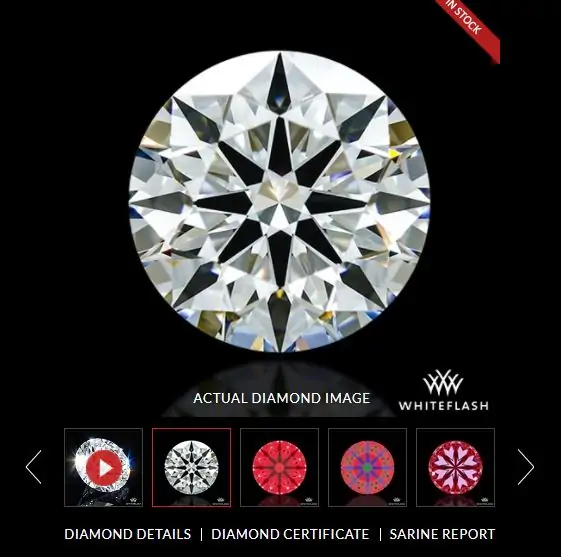
Most retailers have their signature cut grade that goes beyond GIA’s Excellent. If you’re looking for the best cut, check out:
- Whiteflash A Cut Above Diamonds
Round Diamond Color
Choosing your diamond’s color is often based on personal preference, with colorless diamonds being the most popular. The size of the diamond should also be taken into consideration when deciding on the color. Larger diamonds tend to show more color.

The GIA grades diamond color into grades from D to Z, with the colorless grades being the most valuable and sought-after.
The D-F (colorless) diamonds are highly sought after and are the most popular choice. Due to the laws of supply and demand, D-F color grades are the most expensive as buyers are willing to pay more for them. While the visual difference between these grades can be undetectable, there is often a big price difference.
For an Excellent or Very Good grading for color, here are the color grades to look for:
| EXCELLENT | VERY GOOD | POOR | |
| .50 ct. and smaller | D – G | H – I | M + |
| .50 – 1.0 ct. | D – G | H – I | M + |
| 1.0 – 2.0 ct. | D – F | G – H | L + |
| 2.0 ct and larger | D – F | G | J + |
Some people prefer warm toned diamonds that are on the lower end of the scale, such as K grade and lower. This is also a good idea if you’re opting for rose or yellow gold metals for your ring, as the tints in the stone will not be all that noticeable placed next to these metals.
K color grade diamond. See it here.
D color grade diamond. See it here.
If you’re on a budget, drop down on the color scale as far as you’re comfortable to go. The savings will be significant. Check out these two diamonds featured above, that are very similar in every way except that one is a D and the other a K. The difference in price? $4,360!
Round Diamond Clarity
The GIA grades clarity from Flawless (FL – the highest grade) to Included 3 (I3 – the lowest). Choosing the clarity grade of your round diamond depends on your preference. Most people prefer higher clarity grades, often believing that this results in superior sparkle. But this isn’t necessarily true. In reality, there is no visual difference between a FL diamond and a VS2. There will be a huge difference in price, however, all else being equal.
Compare the two diamonds below, which have similar specifications except when it comes to clarity. Even with the Superzoom feature, it’s impossible to notice any flaws in the diamond. However, there is a significant difference in the price.
1.08 Carat F Color FL Clarity Very Good Cut Round Diamond
1.13 Carat F Color VVS2 Clarity Very Good Cut Round Diamond
What does this mean for you as the shopper? As higher clarity grades don’t make a visual difference, and don’t enhance the sparkle of the diamond, it makes financial sense to drop down on the clarity scale.
This is one area where you can drop go for a lower grade and still get a stunning diamond. Most inclusions cannot be seeing by the naked eye, except for the Slightly Included and Included grades.
| EXCELLENT | VERY GOOD | POOR | |
| .50 ct. and smaller | FL – VS2 | SI1 – SI2 | I2 and lower |
| .50 – 1.0 ct. | Fl – VS1 | VS2 – SI1 | I2 and lower |
| 1.0 – 2.0 ct. | Fl – VVS2 | VS1 – VS2 | I1 and lower |
| 2.0 ct and larger | FL – VVS2 | VS1 – VS2 | SI and lower |
Always inspect your diamond before you buy – whether online or in person. Look for HD photos and videos and check the stone from different angles. When it comes to clarity, what’s important is not just if the stone has inclusions but where the inclusions are located, and this is not detailed in lab reports.
Take a look at this random selection of similar diamonds. They all have a clarity grading of SI1 and on a grading report would appear very similar. But looking at the images of these diamonds, it’s clear that some have fewer visible inclusions, while others are highly visible to the naked eye.
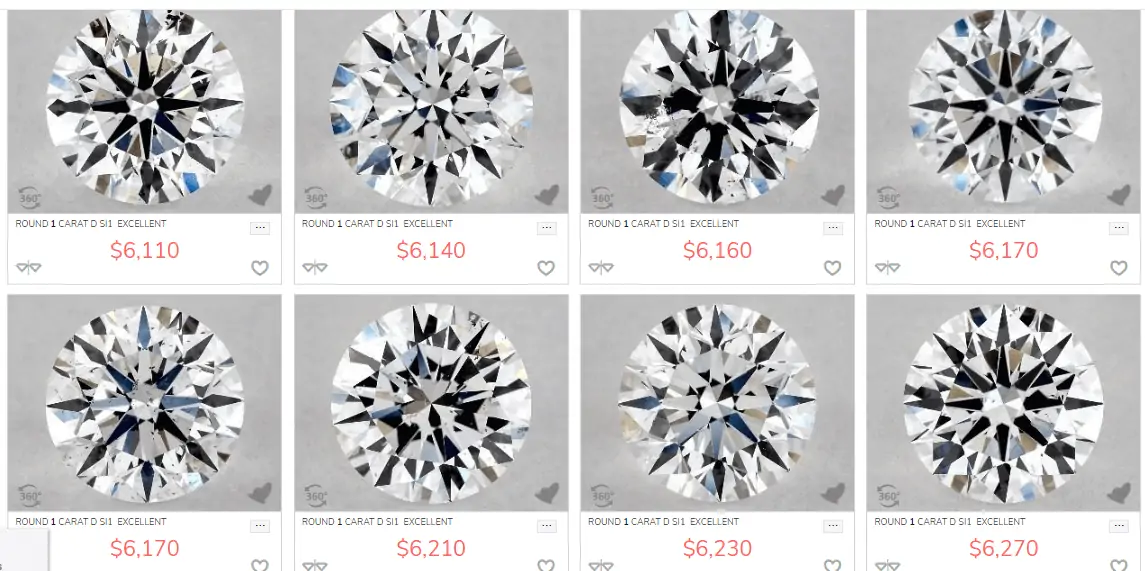
The rule of thumb with clarity is to opt for a stone that contains no visible inclusions, regardless of the grading.
Where to Buy Round Diamonds Online
There are many excellent places to purchase a round diamond online, be it a loose diamond or a pre-set engagement ring. Whichever retailer you decide to go with, always make sure that they are reputable, are specialized in what they do and will provide you with certification. We prefer GIA-certified diamonds, as the lab is known for its stringent quality parameters when assessing diamonds.
We recommend the following retailers:
Why: Superior diamond imaging, competitive prices, high quality, wide range
An online giant in the diamond space, James Allen a stunning collection of high-quality round diamonds. The images and videos are unparalleled in quality and makes shopping online similar, if not better, to shopping in store.
Why: Competitive prices, wide range, great quality
Known for dominating the online diamond industry since the late 1990s, Blue Nile offers one of the largest online diamond inventories. Search round diamonds here at competitive prices, solid after-sales policies, and good customer service.
Why: Superior cut quality, exclusive range, stunning designs
Whiteflash has earned an international reputation for the elite quality of their precision cut diamonds, and for their impeccable collection of designer engagement rings. Check their stunning range of diamond jewelry and loose diamonds.
Why: Impeccable quality, superior cut, small but exclusive inventory
Brian Gavin is a renowned expert in diamond cut – and it shows in their superior diamond quality. For the very best in diamonds, search their inventory of designer diamond jewelry and loose diamonds.
Why: Try before you buy, build your own ring, great quality
If you want to try out how a round diamond ring looks on your finger before you commit to buying one, check out With Clarity’s Home Preview Service which is completely free. Find out more here.
Check out our quick comparison of the top online engagement ring retailers for more information.
Wrapping Up
Round diamonds have been, and will likely continue to be, the most popular diamond cut there is. It’s a classic choice that will never go out of style. While round diamonds are somewhat expensive, they’re also classic, gorgeous, brilliant, and stylish.









